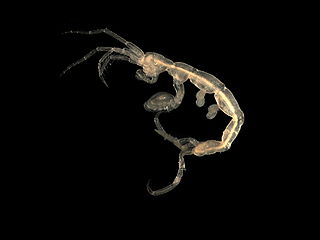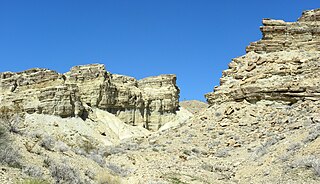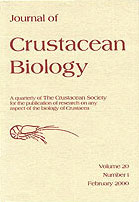
Leptostraca is an order of small, marine crustaceans. Its members, including the well-studied Nebalia, occur throughout the world's oceans and are usually considered to be filter-feeders. It is the only extant order in the subclass Phyllocarida. They are believed to represent the most primitive members of their class, the Malacostraca, and first appear in the fossil record during the Cambrian period.
Frederick Robert Schram is an American palaeontologist and carcinologist. He received his B.S. in biology from Loyola University Chicago in 1965, and a Ph.D. on palaeozoology from the University of Chicago in 1968 .

Corophiida is an infraorder of amphipods that contains the two parvorders Caprellidira and Corophiidira.

Hemigrapsus sanguineus, the Japanese shore crab or Asian shore crab, is a species of crab from East Asia. It has been introduced to several other regions, and is now an invasive species in North America and Europe. It was introduced to these regions by ships from Asia emptying their ballast tanks in coastal waters.

Austropotamobius is a genus of European crayfish in the family Astacidae. It contains four extant species, and one species known from fossils of Barremian age:

Facetotecta is a poorly known subclass of thecostracan crustaceans. The adult forms have never been recognised, and the group is known only from its larvae, the "y-nauplius" and "y-cyprid" larvae. They are mostly found in the north Atlantic Ocean, neritic waters around Japan, and the Mediterranean Basin, where they also survive in brackish water.

Cheiragonidae is a small family of crabs, sometimes called helmet crabs, placed in its own superfamily, Cheriagonoidea. It comprises three extant species, Erimacrus isenbeckii, Telmessus acutidens and Telmessus cheiragonus, there are no yet evidences of Cheiragonidae in the fossil record. Many of these crabs were formerly treated as members of the Atelecyclidae.
Aeschronectida is an extinct order of mantis shrimp-like crustaceans which lived in the Mississippian subperiod in what is now Montana. They exclusively lived in the Carboniferous, or the age of amphibians. They have been found mostly in the U.S. and in the British Isles, in 1979 species were found in the Madera Formation in New Mexico. Aeschronectida was first identified appearing in Continental Europe in around 2014. While sharing similar characteristics to Stomatopoda, they lack certain physical characteristics of that taxon. The first species of Aeschronectida is accredited to Frederick R. Schram. They diverge substantially from typical hoplocaridan morphology by having more unmodified thoracopods. It's theorized that these thoracopods evolved to become more specialized, making them potential ancestors to Stomatopoda.

The Barstow Formation is a series of limestones, conglomerates, sandstones, siltstones and shales exposed in the Mojave Desert near Barstow in San Bernardino County, California.

Archaebranchinecta barstowensis is a species of fairy shrimp (Anostraca) that inhabited California during the Middle Miocene. Its fecal material is abundant in the concretions from the Barstow Formation. A limited number of whole specimens have been found, and they represent the "best-preserved fossil anostracan known to date". The closest relative of A. barstowensis appears to be Archaebranchinecta pollicifera from the surroundings of Lake Titicaca, and the two have been separated from the genus Branchinecta as the new genus Archaebranchinecta.
Eudaniela is a genus of crabs in the family Pseudothelphusidae, containing the following species:
Boeckella palustris is a species of copepod found in South America. It inhabits shallow pools, including the highest body of water ever to have yielded a crustacean, at an altitude of 5,930 m (19,460 ft) in the Andes. It was described independently by two scientists in 1955, using material brought back by different European expeditions to the same region.

Hippa is a genus of decapod crustaceans in the family Hippidae, containing the following species:

Corophiidira is a parvorder of marine amphipod crustaceans in the infraorder Corophiida. In a previous classification, this taxon was treated as an infraorder and was then itself called Corophiida.

Blepharipodidae is a family of sand crabs (Hippoidea), comprising the two genera Blepharipoda and Lophomastix. They are distinguished from the other families in the superfamily Hippoidea by the form of the gills, which are trichobranchiate (filamentous) in Blepharipodidae, but phyllobranchiate (lamellar) in Albuneidae and Hippidae. Fossils belonging to the genus Lophomastix have been found in rocks dating back to the Eocene.

Pyromaia tuberculata is a species of crab in the family Inachoididae.
The Cretaceous crab revolution refers to a major diversification event of brachyuran crabs that took place during the Cretaceous Period, from 145 to 66 million years ago. Nearly 80% of modern groups of crabs originated during this event. The Cretaceous crab revolution is a smaller component of the greater Mesozoic marine revolution.
Niphates is a genus of sea sponges belonging to the family Niphatidae. It is native to the Florida Keys, The Bahamas, and the Caribbean including the Netherlands Antilles, as well as seas around China and St. Martin's Island in the Bay of Bengal, Bangladesh.

Protastacus is an extinct genus of decapod crustaceans that lived in what is now Germany during the early Cretaceous period. The type species is P. politus, and a second species, P. antiquus, is also assigned to the genus. Protastacus grew to around 10 cm (3.9 in) long and had a mostly crayfish-like appearance, with enlarged pincer-bearing appendages and a segmented abdomen. Though formerly assigned to the Astacidae or Nephropoidea, it is currently placed as the only genus in the family Protastacidae, which in turn is the only family in the superfamily Protastacoidea.













